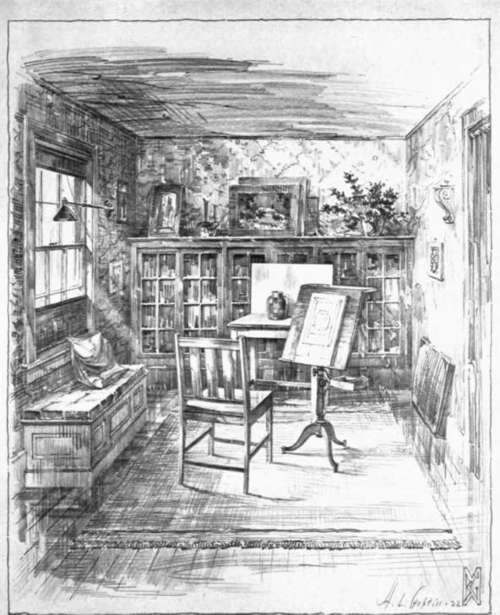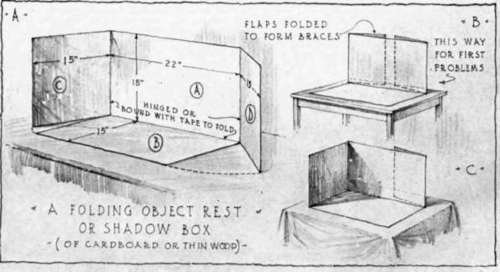Object Drawing In Outline. Part 2
Description
This section is from the "Sketching And Rendering In Pencil" book, by Arthur L. Guptill. Also see Amazon: Sketching And Rendering In Pencil.
Object Drawing In Outline. Part 2
Arranging The Working Space
Now if one is to gain the greatest advantage from his practice, whether the subject is a geometric solid or a bit of still life, he must seek a place where he can work undisturbed, and must have his equipment well chosen and arranged in a convenient way.
A room where one can be alone is ideal, or where the other occupants are engaged in similar pursuits as in an artist's studio or a class room. North light is desirable, for if windows face the east or south or west there will be sunlight streaming in at times during the day, which will cause the shadows and reflected lights on the objects to shift in position and to change in value constantly. North light, on the other hand, is a sort of indirect light, coming not straight from the sun but being largely reflected from the sky. It is more diffused, therefore, and gives softer and less changeable shadows and remains more constant during the whole day, being not so much affected by shifting in the sun's position or by the passage of clouds. And north light is purer in hue, too, less yellow than the direct rays of the sun, though this is of especial advantage only when working in color. Light from too many sources is disturbing, as it causes complexity of shadow and reflection. It is best to have the illumination from one window only, the shades being so arranged that the light may be cut off at either the top or the bottom as desired. (See Figure 1. which is designed to show a practically arranged room for this type of work.) Generally it is the lower half or two-thirds of the window that should be shaded, as light from above gives more pleasing shadows. Many studios are for this reason provided with overhead light from skylights or dormers, though for our purposes the upper half or third of the ordinary window will do very well.
The objects to be drawn should not be too far from this window for if they are they will not only lack sufficient light but the shadows will be too much elongated. If rays fall downward at an angle of about 45 degrees from the left they should prove satisfactory, the objects being from three or four to eight or ten feet from the window.
Object Stand
There should be some sort of stand on which these objects may be placed and usually a small table of average height (about 30") will do very well. One painted white or with a white cover is good. If a dark table is used it will be necessary to cover it with a white or very light cloth or paper on which the objects may rest and show good contrast. A background of the same material should be provided so that sharp relief can be obtained, and the surroundings cut off from view. The diagram Figure 2 shows a method of making a convenient folding object rest or shadow box of heavy cardboard which may be used on any table. Thin wood or wall-board may be substituted if desired. Cut two cardboards "A" and "B" of equal size, about 15"x22", next binding them together with tape in such a way that "A" can be raised to a vertical position while "B" remains horizontal to rest on the table. Flaps "C" and "D," each 15" square, are attached to "A" in the manner shown. Figure 2 gives at "B" and "C" two of several positions in which the box may be used, the first being the best for the early problems.
Chair Or Seat
A simple chair with a rather straight back and no arms is the best - one which though permitting freedom, will at the same time not prove so comfortable as to invite laziness. For in object drawing it is essential that one should sit upright all the time. The chair should be so placed that the student will sit directly facing the objects.

Figure 1. A Room Arranged as a Studio for Object or Cast Drawing.

Figure 2. Illustrating a Method of Making an Object-Rest or Shadow Box.
Easel Or Adjustable Drawing Table
An easel or adjustable drawing table is essential on which the drawing board may rest. Usually this should be kept in an almost vertical position so the sketch is at right angles to the line of sight from the eye. If the board is tipped in some other manner the paper will be so foreshortened as to prevent accurate work, unless one changes his own position so as to still view it at right angles. The type of adjustable table shown in the sketch. Figure 1, has some advantages over the customary easel, especially for the architectural student, for it can be used not only in a great variety of positions as an easel but will also serve as a drafting board or as a table when placed horizontally or nearly so. Easels such as are available in any well stocked artists supply house will do very well, however, those which permit of easy raising or lowering of the drawing to any desired height being the best. Whether table or easel is chosen it should be placed slightly to the right of the student as he faces the objects, just enough to one side to keep it from obstructing the view. This position and the height from the floor should be such as to make it easy to glance from the objects to the drawing and back again.
These three things, then, the stand on which the objects are to rest, the seat, and the easel or adjustable table, are most important and taken together with such smaller necessities as paper and pencil constitute the essential equipment. Cases or drawers or folios in which new paper, finished drawings and the like may be kept are convenient, and in addition there should be some provision made for taking care of the pencils, erasers and knives which must be near at hand. Attachments may be purchased for the type of table pictured in Figure 1. specially designed to accommodate such accessories, whereas the easel is usually equipped with a shelf to serve the same purpose. Some of the stands made for smokers are convenient if we substitute pencils and sandpaper pad for pipe and tobacco. As an added improvement to the studio a shelf should be provided where the drawing may be placed from time to time for comparison with the objects drawn. The top of the cases shown in Figure 1 would answer for this purpose (these cases, by the way, allow for storage of still-life, casts, etc., as well as books and drawings) though a rest or shelf right beside the objects would be still better. Students sometimes have a portable music rack such as musicians use placed near the object stand so they are able to set the drawing side by side with the subject for study and comparison.
Continue to:


